Sophie-Luise Passow (*1994, Vienna) studied photography in the class of German artist and professor Gabriele Rothemann as well as graphics and printmaking with the Swedish artist and professor Jan Svenungsson at the University of Applied Arts, Vienna. Sophie-Luise graduated from the academy last summer with an artistic composition that addressed the notion of Waiting (Bitte Warten). The materials used epitomise and celebrate a sort of inherent fragility that is deeply characteristic of the process of living.

Self-portrait © Sophie-Luise Passow, courtesy of the artist
Erka Shalari: You have recently graduated, how does that feel? During your thesis defense, there was some heated discussion surrounding your conception of Waiting. What was the reason for that, do you think?
Sophie-Luise Passow: Graduation launches you onto a path of willy-nilly independence and, as a result, hopefully self-sufficiency as well. My studies at the arts academy took six years. At first I specialised in photography and then moved to graphics and printmaking. It didn’t feel like a particularly long journey, in fact it is almost like I have grown younger than I was before. In general, whenever I am learning something new, I seem to have the feeling of growing younger. I have learned so much during this time and, luckily, there should always be more things to learn. When it comes to my final project, I was playing with the concept of waiting, weaving it together with five themes from existentialism, which were death, fear, responsibility, action and freedom. In contrast to the usual notion of waiting as passive, I see it as an inherently active process. I view myself as constantly waiting for next steps, even if their gradual emergence isn’t something I am or can be conscious of. Of course, I fully grant that how every person engages with the activity of waiting differs depending on their individual perspective. That’s why in the written part of my final project I tried to slip into and channel five different viewpoints—I, YOU, HIM, HER, THEY—as a means of exploring the five existentialist themes I mentioned in greater detail. The end result was a kind of overarching narrative spanning multiple interrelated and yet distinct epistemological standpoints—all in conversation with one another—riffing on the most important of questions. It is true that I received quite a few questions, which I see as a positive outcome. Several people had a very different take on the notion of waiting, some of them seemed bothered by my conception, others were intrigued by my point of view. I understand that if you hold an idea of waiting as an intrinsically unproductive activity, you would aim to avoid being in this position at all cost, and my rethink of it may feel off. Curiously, I guess my studies helped me develop a more positive set of associations with waiting actually. I mean, six years is a while in a more straightforward way too.

Sophie-Luise Passow, Bitte Warten, 2022. Installation view at Universität für angewandte
Kunst, Foto © Jorit Aust, courtesy of the artist
How can you tell when something you’ve created forms a series of works rather than individual pieces? I have always been curious about this.
I can just talk about how it is in my case and not in general. My artistic approach is to tell a story that brings up and expands on references to symbols that we are already familiar with. It is in the process of reworking and recreating them continuously that a series eventually emerges for me.
If someone were to ask, how would you describe your medium?
I would say I have tools I work with. To have the best shot at expressing myself fully, I find it most helpful to explore the connections between drawing, painting, writing, and photography. There is no single medium I feel bound or committed to. These days I am mainly known for working with painting and drawing but in fact I have kept on playing with the other tools in parallel.
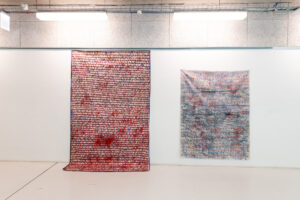
Sophie-Luise Passow, Bitte Warten, 2022. Installation view at Universität für angewandte Kunst, Foto © Jorit Aust, courtesy of the artist
What is your process working with different types of media? Does it vary at all?
One of my artistic approaches is questioning the existence of “true” origins and the relationship between the original, its reproductions, and still further copies of copies. So it is quite useful to switch between techniques for expression and to use them in non-traditional ways. It is like an extension of the visual process and in practicing it I see, learn, and create new perspectives on themes that I am drawn to for various reasons.
You often use soft and oil pastels, which can be pretty fragile. Aren’t you worried that your art pieces might get damaged over time?
I like the idea of changing and “growing” and there is a sense in which the inherent fragility of my materials embodies that. External conditions can change my body of work over time but I see that as an analogy to life, as this can and does happen to everything. However, at the same time there is a specific process by which I use fixatives on my paintings, such that they are actually less vulnerable than other types of canvases in some ways, particularly when it comes to transportation and installation. As a result, as soon as they make it on a wall, they can generally represent stability and permanence just as well.
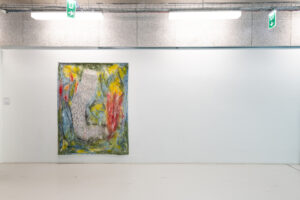
Sophie-Luise Passow, Bitte Warten, 2022. Installation view at Universität für angewandte Kunst, Foto © Jorit Aust, courtesy of the artist
Who did you originally want to become and is your childhood idea of yourself still with you in any meaningful sense?
I started playing tennis when I was a little over three years old. As a child, I have always wanted to become a professional tennis player, but my mind has changed around when I turned fourteen. Nonetheless, passion, rhythm, and mental strength are aspects of the game I have continued to carry with me in significant ways.
To what extent is your physical body involved in your art, would you say?
For me, filling large-format paintings means moving from side to side with my whole body. Picture a person who climbs or strives for a goal that can only be reached through many intermediate steps at different points of a geographical location. It is a journey expressed and taken on canvas. I also use photography as a tool in which my body takes on a performative role as a means of playing with the notion of self-reflection.
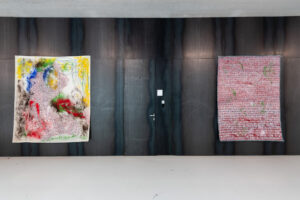
Sophie-Luise Passow, Bitte Warten, 2022. Installation view at Universität für angewandte Kunst, Foto © Jorit Aust, courtesy of the artist
When I visited your studio, you briefly showed me a cover of one of your diaries. Do you still keep one and, if so, what function does that serve for you?
I was fourteen years old when I started trying to express my inner world in diaries. They are a sort of archive, where I go to analyse, rethink, and understand myself better from the inside and also in relation to the outside world. As a kind of personal history in collecting memories, my diaries are not always in written form. Some of them contain my attempts at visualising memory and thought as well.
What role does the act of writing play in your artistic practice?
Writing is the first step I take after I have an idea for a piece. It fills multiple roles, including those of documentation, research as well as creation. This is actually one of the most characteristic elements in my work and yet it is also invisible in a way, since I don’t tend to share that as a key part of my practice. I like playing with what I think of as codes in general and make them somewhat hidden and so not quite straightforward to crack.
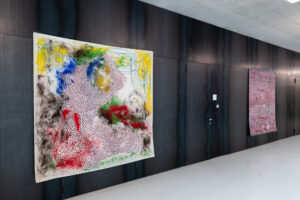
Sophie – Luise Passow, Bitte Warten, 2022. Installation view at Universität für angewandte Kunst, Foto © Jorit Aust, courtesy of the artist
What is the importance of routines for you? For instance, I hear you’re an avid cyclist, is that true?
Routine is my method to develop and entrench my chosen interests by practicing every day. At least I’m hoping I am gaining self-awareness through it. I also conceptualise very simple routines like making myself a cup of good coffee in the morning as a form of self-love. I have recently bought myself a portafilter machine which opens new possibilities in that regard. I love being in motion and my bike is the main representation of that. You would rarely see me without a bike – except maybe when I’m traveling or when I was living in Paris last year. Aware of the fact that I’m a speedy cyclist, I decided against taking it with me for Parisian metropolis-related safety considerations, let’s say.
Speaking of movement, you are currently visiting Akademie Schloss Solitude. How did you end up there and what is it like?
I’m very lucky to have been invited as a guest to the Akademie Schloss Solitude. The name of this 18th century German castle—„Solitude“—reflects the atmosphere around it. Walking in the forest, surrounded by silence, being focused on my thoughts, listening to podcasts, working in the studio is my daily routine at this place. It has been very enriching so far. Besides that though, I have been getting to know a number of artists and scientists at the residency, which is in an interesting sense the opposite of being solitary. It is impressive when it comes to cultural differences and the various interests and viewpoints that every person brings to that place.
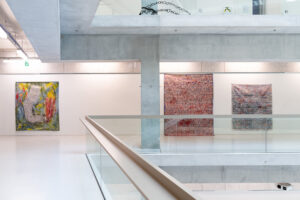
Sophie-Luise Passow, Bitte Warten, 2022. Installation view at Universität für angewandte Kunst, Foto © Jorit Aust, courtesy of the artist
What do you think is the role of such residencies?
To support your artistic approach, expand your social network, and give you the facilities to enrich and extend your practice further.
And finally, what are you working on at the moment?
Last spring I started to work on my part in a collective book with other artists which has yielded a personal approach regarding crosses as symbols in landscapes. As a result of this project, I have been creating a series exploring the interconnections between war, religion, and social systems. Another project is a collaboration with an academic researcher who invited me to the Akademie Schloss Solitude as her guest. We are considering exploring the implications of some of the latest cognitive science frameworks in the form of mixed visual media. I have a solo show in the works for March 2023 and so there is still a lot to do for that too.
Erka Shalari
Info:
www.instagram.com/sophielou_passow/
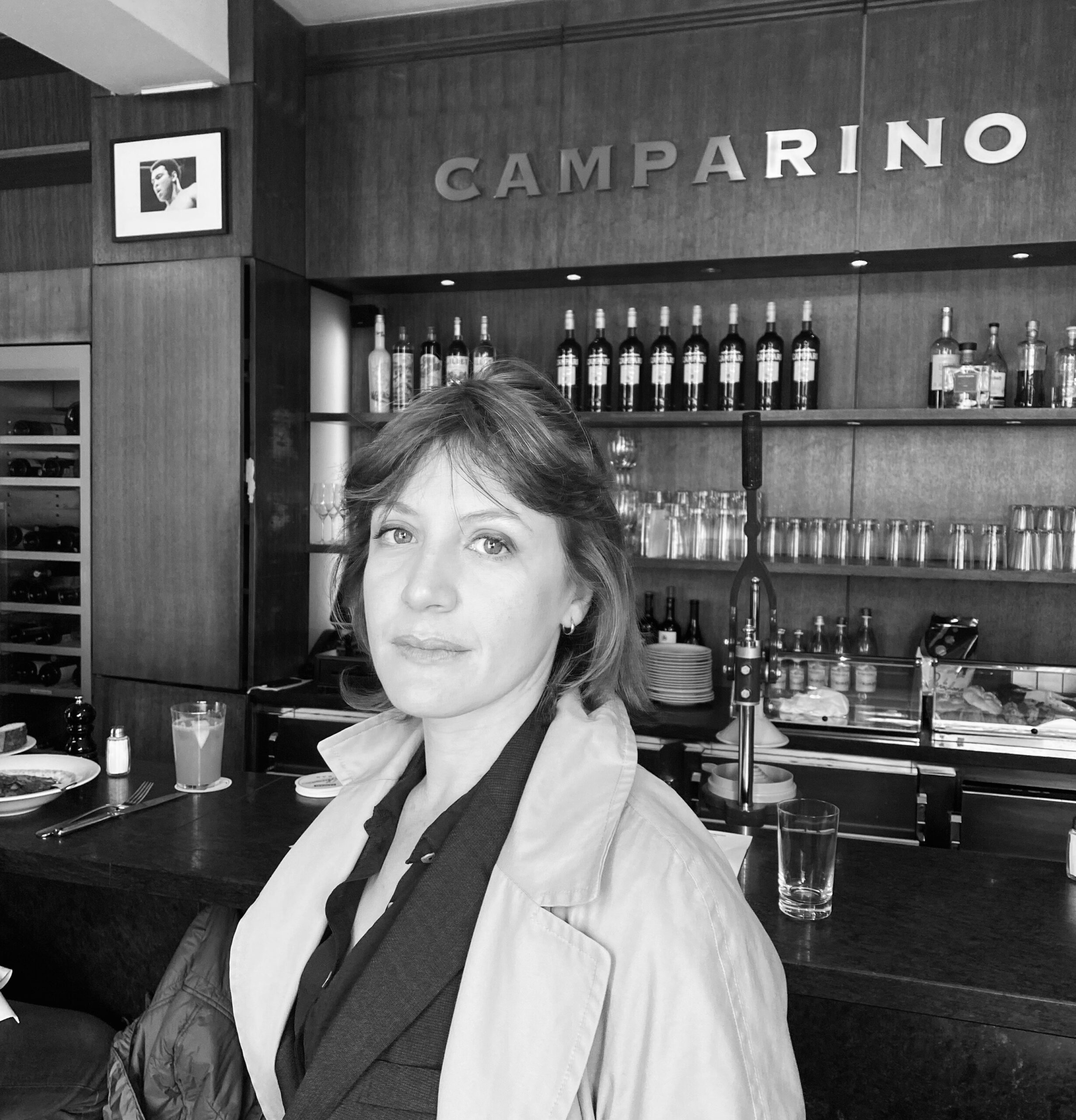
Erka Shalari is a Vienna based art writer and editor. Her work is committed to uncovering distinctive artistic positions in contemporary art. The work methodology is strongly influenced by psychology, epistemological works, as well as affects and rituals.




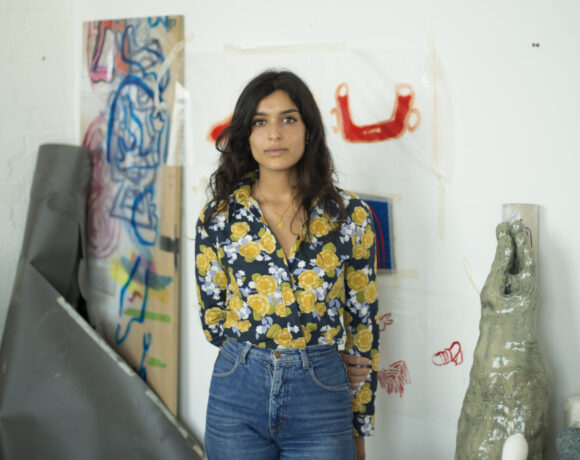

NO COMMENT